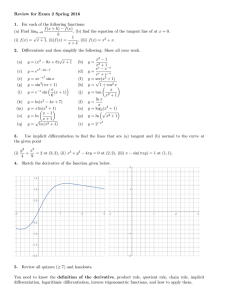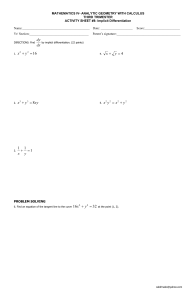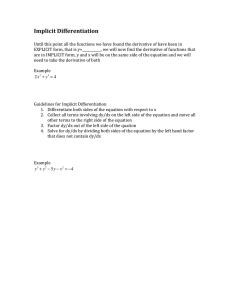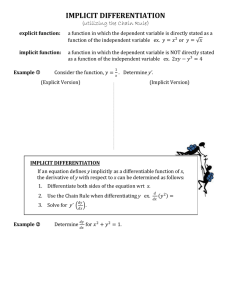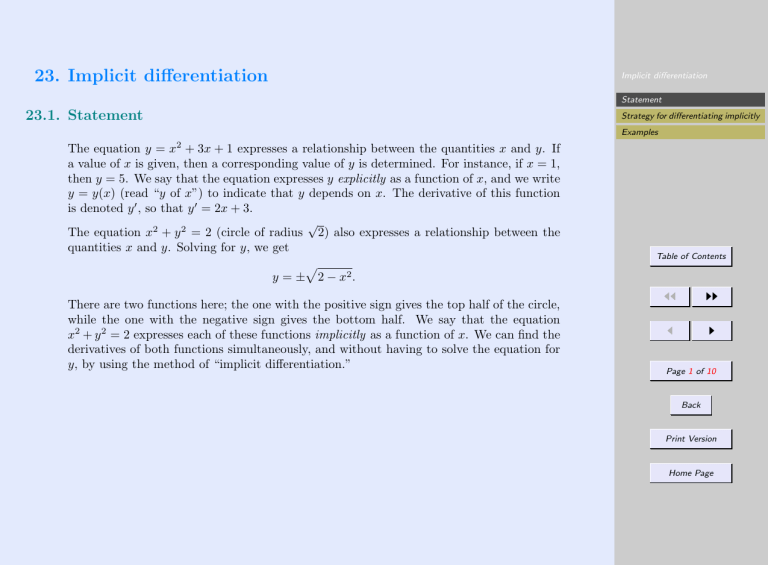
23. Implicit differentiation Implicit differentiation Statement 23.1. Statement Strategy for differentiating implicitly Examples 2 The equation y = x + 3x + 1 expresses a relationship between the quantities x and y. If a value of x is given, then a corresponding value of y is determined. For instance, if x = 1, then y = 5. We say that the equation expresses y explicitly as a function of x, and we write y = y(x) (read “y of x”) to indicate that y depends on x. The derivative of this function is denoted y 0 , so that y 0 = 2x + 3. √ The equation x2 + y 2 = 2 (circle of radius 2) also expresses a relationship between the quantities x and y. Solving for y, we get p y = ± 2 − x2 . There are two functions here; the one with the positive sign gives the top half of the circle, while the one with the negative sign gives the bottom half. We say that the equation x2 + y 2 = 2 expresses each of these functions implicitly as a function of x. We can find the derivatives of both functions simultaneously, and without having to solve the equation for y, by using the method of “implicit differentiation.” Table of Contents JJ II J I Page 1 of 10 Back Print Version Home Page Implicit differentiation Method of implicit differentiation. Given an equation involving the variables x and y, the derivative of y is found using implicit differentiation as follows: d to both sides of the equation. (In the process of applying Apply dx the derivative rules, y 0 will appear, possibly more than once.) Statement Strategy for differentiating implicitly Examples Solve for y 0 . 23.1.1 Example Given x2 + y 2 = 2, find y 0 and use it to find the slopes of the lines tangent to the graph of the equation at the points (1, 1) and (1, −1) as follows: Table of Contents (a) use implicit differentiation, JJ II J I (b) solve for y first. Also, sketch the graph of the equation and the tangent lines. Page 2 of 10 Solution (a) Using the method of implicit differentiation, we apply d to both sides of the equation dx Back Print Version Home Page and then solve for y 0 : Implicit differentiation d 2 d x + y2 = [2] dx dx d 2 d 2 x + y =0 dx dx 2x + 2yy 0 = 0 x y0 = − . y Statement Strategy for differentiating implicitly Examples (The chain rule was used in the next to the last step.) The slopes of the tangent lines at the points (1, 1) and (1, −1) are, respectively, y 0 |(1,1) = − 1 = −1 1 and y 0 |(1,−1) = − 1 = 1. −1 √ (b) The point (1, 1) is on the graph of y = 2 − x2 (top half of circle). The derivative of this function is i d hp 2 − x2 = 12 (2 − x2 )−1/2 · −2x, y0 = dx so the slope at (1, 1) is y 0 |1 = 21 (2 − (1)2 )−1/2 · (−2)(1) = −1. Similarly, the point √ (1, −1) is on the graph of y = − 2 − x2 (bottom half of circle). The derivative of this function is i d h p y0 = − 2 − x2 = − 12 (2 − x2 )−1/2 · −2x, dx 0 so the slope at (1, −1) is y |1 = Here is the sketch: − 12 (2 2 −1/2 − (1) ) Table of Contents JJ II J I Page 3 of 10 Back Print Version · (−2)(1) = 1. Home Page Implicit differentiation Statement Strategy for differentiating implicitly Examples Table of Contents The example illustrates the fact that it is usually much easier to use implicit differentiation than it is to first solve the equation for y. When an equation gives y explicitly as a function of x, meaning that the equation has y on one side and an expression involving only x’s on the other, then the derivative y 0 equals an expression involving only x’s, so to find the slope of the line tangent to the graph of the equation at a point, one needs only the x-coordinate of the point (see solution to (b) in last example). By contrast, when an equation gives y implicitly as a function of x, the formula for the derivative y 0 typically involves both x’s and y’s, so both coordinates of a point are required in order to find the slope of the tangent at that point (see solution to (a)). This is un- JJ II J I Page 4 of 10 Back Print Version Home Page derstandable since an equation giving a function implicitly usually gives more than one function (for instance x2 + y 2 = 2 gives the top half of the circle and also the bottom half); an x-coordinate alone does not determine which of the functions is intended, so the y-coordinate must also be supplied. Implicit differentiation Statement Strategy for differentiating implicitly Examples 23.2. Strategy for differentiating implicitly In carrying out implicit differentiation, one needs to keep in mind that y represents a function of x (although an explicit formula might not be known). In deciding which derivative rules to apply, it is useful to think what you would do for a particular y, say, y = sin x. For instance, in the next example, in order to find the derivative of xy one should use the product rule since x sin x requires the product rule; in order to find the derivative of y 3 one 3 should use the chain rule since (sin x) requires the chain rule. 23.2.1 Example Given x + xy − y 3 = 7, find y 0 . Table of Contents JJ II J I Page 5 of 10 Back Print Version Home Page Solution Using the method of implicit differentiation, we have d d x + xy − y 3 = [7] dx dx d d d 3 [x] + [xy] − y =0 dx dx dx d d 1+ [x] y + x [y] − 3y 2 y 0 = 0 dx dx 1 + (y + xy 0 ) − 3y 2 y 0 = 0 y 0 x − 3y 2 = −1 − y 1+y −1 − y . = 2 y0 = x − 3y 2 3y − x Implicit differentiation Statement Strategy for differentiating implicitly Examples Table of Contents (The third line was obtained using the product rule and the chain rule.) 23.3. Examples The next example shows the usefulness of implicit differentiation for situations where there is no obvious way to solve the equation for y. 23.3.1 Example Given ex 2 y = x + y, find y 0 . JJ II J I Page 6 of 10 Back Print Version Home Page Solution Using the method of implicit differentiation, we have d h x2 y i d e = [x + y] dx dx 2 d d d 2 ex y x y = [x] + [y] dx dx dx 2 d 2 d ex y x y + x2 [y] = 1 + y 0 dx dx 2 ex y 2xy + x2 y 0 = 1 + y 0 2 2 y 0 x2 ex y − 1 = 1 − 2xyex y Implicit differentiation Statement Strategy for differentiating implicitly Examples 2 y0 = 23.3.2 Example Given cos(xy) = 2y , find y 0 . x3 1 − 2xyex y . x2 ex2 y − 1 Table of Contents JJ II J I Page 7 of 10 Back Print Version Home Page Solution Using the method of implicit differentiation, we have d d 2y [cos(xy)] = dx dx x3 d 3 d y [2 ] − 2y x x3 d dx dx − sin(xy) [xy] = 2 dx (x3 ) x3 (2y (ln 2)y 0 ) − 2y (3x2 ) − sin(xy)(1y + xy 0 ) = x6 y 2 ln 2 3 · 2y y 0 −x sin(xy) − = y sin(xy) − x3 x4 3 · 2y y sin(xy) − x4 y0 = 2y ln 2 −x sin(xy) − x3 y 4 3 · 2 − x y sin(xy) y0 = 5 . x sin(xy) + x2y ln 2 (In the last step, the complex fraction was simplified by multiplying numerator and denominator by x4 . Also, numerator and denominator were multiplied by −1 in order to reduce the number of negative signs.) Implicit differentiation Statement Strategy for differentiating implicitly Examples Table of Contents JJ II J I Page 8 of 10 Back 23.3.3 Example Find all points on the graph of x4 + y 4 + 2 = 4xy 3 at which the tangent line is horizontal. Solution A horizontal line has slope zero, so the horizontal tangent lines occur at points on the graph where the derivative is zero. We compute the derivative using the method of Print Version Home Page Implicit differentiation implicit differentiation: d d 4 x + y4 + 2 = 4xy 3 dx dx 4x3 + 4y 3 y 0 = 4y 3 + 4x(3y 2 y 0 ) Statement Strategy for differentiating implicitly Examples y 0 (4y 3 − 12xy 2 ) = 4y 3 − 4x3 y0 = 4y 3 − 4x3 y 3 − x3 = 3 . 3 2 4y − 12xy y − 3xy 2 Setting y 0 = 0, we get y 3 − x3 y 3 − 3xy 2 y 3 − x3 = 0 0= y 3 = x3 Table of Contents JJ II J I y = x, So a horizontal tangent line occurs at the point (x, y) on the graph if and only if y = x. In order for the point to be on the graph, its coordinates must satisfy the equation: x4 + y 4 + 2 = 4xy 3 x4 + x4 + 2 = 4x4 Page 9 of 10 Back x4 = 1 x = ±1. The only candidates for such points are (1, 1) and (−1, −1). Both of these points lie on the graph, so the answer is (1, 1) and (−1, −1). Print Version Home Page 23 – Exercises Implicit differentiation Statement Strategy for differentiating implicitly Examples 23 – 1 2 0 Given y = x, find y and use it to find the slopes of the lines tangent to the graph of the equation at the points (4, 2) and (4, −2) as follows: (a) use implicit differentiation, (b) solve for y first. Also, sketch the graph of the equation and the tangent lines. Table of Contents 23 – 2 23 – 3 Given 2xy + y 2 = x + y, use implicit differentiation to find y 0 . Let √ x + y = 1 + x2 y 2 . (a) Find y 0 . (b) Find an equation of the line tangent to the graph of the given equation at the point (0, 1). JJ II J I Page 10 of 10 Back Print Version 23 – 4 Given x sin ey = ln y, find y 0 . Home Page
